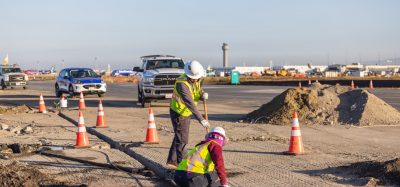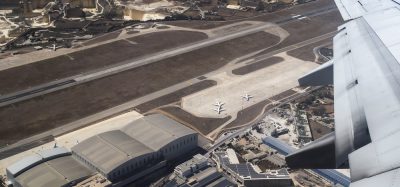Friction testing through the years
- Like
- Digg
- Del
- Tumblr
- VKontakte
- Buffer
- Love This
- Odnoklassniki
- Meneame
- Blogger
- Amazon
- Yahoo Mail
- Gmail
- AOL
- Newsvine
- HackerNews
- Evernote
- MySpace
- Mail.ru
- Viadeo
- Line
- Comments
- Yummly
- SMS
- Viber
- Telegram
- Subscribe
- Skype
- Facebook Messenger
- Kakao
- LiveJournal
- Yammer
- Edgar
- Fintel
- Mix
- Instapaper
- Copy Link
Posted: 8 December 2011 | Armann Norheim, Leader of the ICAO Friction Task Force (FTF) | No comments yet
The history of the world includes many well known inventions which have had a significant influence on technological developments. One of these is the Dynamometer, a device used for measuring force, moment of force (torque) and power. Dynamometers have been a vital and necessary component in instruments that can identify the friction developed between a tyre and the surface it acts upon.
The principle used is an invention that is nearly 450 years old. The instrument indicates weight or pressure by making use of Hookes law1 of elasticity which states that “the extension of a spring is in direct proportion with the load applied to it”. In this article we will look into the history of tractive resistance within the transportation sector up to the advent of the jet aircraft.
France, 1798
Long before the birth of aviation, in the early 1780s Edme Régnier started the development of what came to be known as The Régnier Dynamometer2. Régnier was encouraged by two naturalists (Buffon and Guéneau of Montbelliard) who desired a device by which a man’s strength would be rendered comparable to that of another. The French revolution came, Buffon and Guéneau died and Régnier became inspector of the manufacture of portable arms. In 1796 the physician Coulomb urged Régnier to resume his work in view of the developing industry. Régnier’s Description et usage du Dynamomtre appeared in 1798.
The history of the world includes many well known inventions which have had a significant influence on technological developments. One of these is the Dynamometer, a device used for measuring force, moment of force (torque) and power. Dynamometers have been a vital and necessary component in instruments that can identify the friction developed between a tyre and the surface it acts upon.
The principle used is an invention that is nearly 450 years old. The instrument indicates weight or pressure by making use of Hookes law1 of elasticity which states that “the extension of a spring is in direct proportion with the load applied to it”. In this article we will look into the history of tractive resistance within the transportation sector up to the advent of the jet aircraft.
France, 1798
Long before the birth of aviation, in the early 1780s Edme Régnier started the development of what came to be known as The Régnier Dynamometer2. Régnier was encouraged by two naturalists (Buffon and Guéneau of Montbelliard) who desired a device by which a man’s strength would be rendered comparable to that of another. The French revolution came, Buffon and Guéneau died and Régnier became inspector of the manufacture of portable arms. In 1796 the physician Coulomb urged Régnier to resume his work in view of the developing industry. Régnier’s Description et usage du Dynamomtre appeared in 1798.
Régnier’s dynamometer was used for testing the strength of bridled work animals, but particularly for testing and comparing the strengths of horses. It could also determine the efficiency of a carriage with well-mounted and well-made wheels, and appreciate the resistance of a loaded carriage according to the slope of a hill. In addition to this, Régnier’s dynamometer was capable of testing the strengths of motors, weighing loads, measuring the recoil of large firearms and consequently the force of a missile. The instrument would measure in myriagrams3 and kilograms. Régnier put forward several protocols and cautions to guide users and claimed that measurements were only comparative, rather than absolute, influenced as they were; “by our exercise, our manner of living and our customs.”
Marriot’s dynamometer in the UK
In the UK, whilst Régnier’s dynamometer was being further developed, a Mr. Marriot of London developed an instrument which was brought into extensive use. However, the following description, in the Register of arts and journal of patent inventions (1828) outlines the lack of progress that Mr.Marriot actually made;
“Marriott’s royal patent dynamometer, invented by Régnier about fifty years ago, and since published in many of the scientific journals. We do not perceive that Mr. Marriot has made the least improvement or even alteration in it, although he calls it his patent. Mr. H.R. Palmer, the civil engineer, did, however introduce an improvement upon Régnier’s dynamometer about four years ago….”
The aforementioned Mr. Palmer improved the dynamometer by preventing the vibratory and trembling motions from jerks on the index enabling readings with a higher accuracy, first by applying a semi-circular vessel filled with water (1823-24) and later a cylinder filled with oil (1826). This dynamometer was used for measuring the resistance on roads and railways.
The UK, 1830
If we move again to the UK we find an improved dynamometer being used within the road and rail industries, it became known as the Road Indicator. It was presented to the House of Commons through the Seventh Report of the Commissioners for the further improvement of the road from London to Holyhead and of the road from London to Liverpool.
When introduced, the instrument was read by walking alongside the road indicator, it was later improved by adding;
“a contrivance for making the instrument itself record the degree of force exerted at each moment of motion. It likewise registers the distance passed over, and the rises and falls of the road. This valuable instrument affords a means of ascertaining the exact power required to draw a carriage over any line of road; it will thus enable one line of road to be compared with another, and their precise amount of difference in case of draught, to be determined; it will show the comparative value of the different methods of improving the surface; and it will enable a registry to be kept from year to year of the state of a road, showing where and how much it has improved or deteriorated, and therefore how judiciously, or the contrary, the funds expended on it have been applied7.”
The mean force and the Road Indicator
The dynamometer (Road Indicator) used during this period was primarily utilised as a comparison tool with the mean force being measured in lbs. This comparison was made between an old and a new road between Barnet and South Mimms. The results were interesting;
“The result derived from this calculation depends not on any theory or abstruse calculation; it is a matter of fact, and cannot be disputed; and is, perhaps, one of the most useful practical applications of the Road Instrument; for without it the most refined and difficult application of algebra to the plans and sections of the above roads would only give an approximate value, as the state of the surface could not be brought into the calculation, except by guess, and this would be little better than judging by the sections, as heretofore practiced; without any decided or fixed principle.”
The same principle is still voiced today. A measured value is better than an assessment, however this is not always a true statement, it depends on many factors and for that reason more emphasis should be placed on the four last words in the above quotation; “decided or fixed principle”, which has been, and still is a challenge for the automotive and aeronautical industry on a global scale. Developing decided or fixed principles across State borders involves the development of regional and global standards.
The US, 1923-1933
And so to America, at the beginning of the 1900s, where Thomas Radford of the Engineering Experiment Station at Iowa State College, published Tractive Resistance and Related Characteristics on Roadway Surfaces in 1924 and Tractive Resistance of Automobiles and Co-efficients of Pneumatic Tyres in 1928. These are the first recorded series of skid tests performed in the United States. The tests were performed at low speeds in excess of four to five mph. From the 1928 report;
“The term ‘tractive resistance’ is usually interpreted to mean a hypothetical force whose line of action is parallel to the road surface and the longitudinal axis of the vehicle, and whose magnitude is equal to the summation of the components in that all external forces acting upon the vehicle when it is travelling on a level surface. It may simplify the discussion of tractive resistance if its several components are considered separately.”
These components are:
1. Rolling resistance
2. Air resistance
3. Impact resistance
Regarding the quantity measured, the report refers to;
“The term ‘co-efficient of friction’ (which) is commonly used to designate the force in pounds required to slide one pound of a material on a level surface of any designated kind. As employed in this report, the term co-efficient of friction, indicates the force required to cause the tyres to slide, divided by the normal pressure between tyres and road surface..”
John W. Schupe in his 1958 report8 states:
“Additional skidding measurements were undertaken at Iowa State College in 1932 and 1933 with R. A. Moyer in charge. The reports of this early research are classics on the subject of determining the skidding resistance of pavement surfaces. Subsequent field investigations have done little to improve the testing procedures and techniques of this early study, other than to take advantage of the developments in measuring and recording equipment which have occurred since that time.
The majority of the testing was accomplished by towing a 2-wheel trailer in such a manner that the towing force was transmitted through an integrating dynamometer. This dynamometer measured the force required to pull the trailer before and after the trailer wheels were locked, and indicated the maximum braking force that each surface was capable of developing. These tests were performed at speeds of 5 to 40 mph. Lateral skidding resistance was determined by towing the trailer at an angle and measuring the side thrust. Impending skidding resistance was also determined by gradually increasing the braking effort to the point where locking of the wheels was impending. In addition, passenger car stopping distance tests were performed on a large variety of surface types. Some of the major findings of Moyer’s 1932-33 research were as follows:
1. There is a decrease in the skidding resistance of pavement surfaces with an increase in speed.
2. This decrease is much greater on wet surfaces than on dry.
3. For similar surface types at comparable age, skidding resistance is higher on highways having a low traffic volume than on those with a higher incidence of traffic.
4. All surface types are more slippery when wet than in dry condition.
5. The best surfaces from the anti-skid stand – point when wet are the sandstone type of rock asphalt surfaces having a ‘sandpaper’ texture.
6. The surfaces which exhibit the poorest wet skid resistance are the glazed or ‘bleeding’ asphalt surfaces.
7. Portland cement concrete pavements do not exhibit the range in values that are noted with bituminous surfaces, and, in general, possesses adequate skid resistance.
8. A tyre having good tread pattern will give better skidding protection than a smooth tread tyre on a wet surface.
9. A vehicle can develop a much greater braking force in the impending skidding condition, as compared to a wheels-locked skid.
10. A wet pavement surface possesses adequate resistance if capable of developing a coefficient of friction of 0.4 in a straight wheels-locked skid.
11. There is a seasonal difference in the skidding resistance of a given pavement surface due to the presence of a traffic film during the summer months.
The Oregon Highway Department made a similar study in the late 1930’s using the Iowa State College dynamometer. Their findings substantiated the work at Iowa State with regard to the effects of speed, moisture, traffic film, and a glazed surface, but indicated that the best wet anti-skid surface were opentextured pavements which provided ready drainage of the water.”
France, 1936
In France, Georges Mathieu9 summarised all information available in 1936 from Great Britain, USA, France, Holland, Sweden, Italy and Germany and in addition gives details on the comprehensive tests organised by the SFERB (le Syndicat des Fabricants d’Emulsion Routiéres de Bitume).
The US, 1942 and aviation
In the early 1940s the aviation community began to show interest in pavement testing. At the suggestion of Dr. Edward Warner10 of the Civil Aeronautics Board, the NACA11 reviewed available information on tyre friction coefficients with particular reference to the effects of field condition on co-efficients available for braking. In June 1942 the report was published12 as an Advance Restricted Report.
“Sufficient published information was found on the effect of surface type and condition and on tyre tread on braking friction coefficients to establish the limits imposed on most of the combinations normally anticipated. Most of this information resulted from highway research, and these results are directly applicable to airplanes during ground runs. While all available data of this nature were reviewed, references 1, 2, and 3 cover the subject well; other consulted sources largely served to check rather than to add to the information contained in these papers.”
Reference one points to the work of Moyer from 1932-33 whilst references two and three to the Committee on Winter Driving Hazards and a 1940 publication called Lake Cadillac Skidding and Traction Tests. One should note that it was considered that the results from highway research were directly applicable to aircrafts during ground runs. For the purpose of this article, the aircraft of this period are represented in an advertisement for Flight magazine. 1942 is also the year when the 1.67 and 1.43 dispatch factors on landing distance determination were introduced into US regulation13, factors that are still in use today.
The UK, 1949 and the co-efficients of friction
In 1949, the UK presented a summary14 of information on the co-efficients of friction between tyres and road or runway surfaces. It was prepared on behalf of the Royal Aeronautical Society’s Performance Sub Committee after visits to the Road Research Laboratory, the Dunlop Rubber Company and the Royal Aircraft Establishment and with reference to available literature at the time.
So far, most of the tests made had been primarily comparative to distinguish between the motorists’ viewpoint of a good and bad road. Referenced were two aviation related tests/experiments. One by recent US Air Force tests on dry concrete clocked at speeds between 30 and 110 mph and one by Dunlop giving estimates on friction co-efficients for sliding locked wheels on dry concrete and on dry and wet grass at the speeds 30, 80 and 110 mph. Again, an advert from Flight magazine in 1948 shows the type of aircraft being tested during this era.
Entering the 1950s
On the automotive side, one can note that there was a long history where the main focus had been on comparative studies distinguishing good roads from bad roads. Tests had been performed at low speeds compared to aviation. On the aviation side much focus and deep concern had been on tyre wear, to such an extent that engineers had been asked to construct smooth runway pavements. The findings of Moyer from early the 1930s that the “best wet anti-skid surface were open textured pavements which provided ready drainage of the water,” seemed not to have been given the necessary consideration. The following words from the UK Superintending Engineer, Air Ministry (1959) make for fascinating reading;
“Until a few years ago the demand had been for the smoothest possible runway surface, but when the airfield engineer, having achieved this, was told that runways were too smooth, surface-dressing treatments followed, and the complaint was then made of excessive tyre wear.”
The advent of jet aircrafts with higher take-off and landing speeds prompted the aviation industry to conduct their own research on friction. Special focus was on the landing case as there was no longer considered to be a direct relationship between highway research and aircrafts behaviour during ground runs.
About the Author
Mr. Norheim has over 20 years of experience in management of airports with special focus on pavement surface conditions and reporting. He was the driving force behind estab lishing and running Avinors purpose built test track for evaluation of surface characteristics of asphalt surfaces and involved measuring techniques. He has establishied the real time touch screen reporting system used at Norwegian airports. Currently he is the leader of the ICAO Friction Task Force (FTF) who evaluate the related ICAO documentation and proposes changes and future activities.
References
1. Named after Robert Hooke (1635-1703), English physicist, chemist, and inventor. Hookes law. He firsted stated this law as an analgram in 1660 and published its solution in 1678.
2. Iron Grip Magazine, Vol. 2, No. 3, July 2002, The History of the Régenier Dynamometer By David Horne and Elizabeth Talbot.
3. Myriagram – An obsolete unit of mass of 10,000 grams, or 10 kilograms.
4. Régnier, Edmé (1798), Description et usage du dynamometre.
5. Luke Herbert, (1836) The engineer’s and mechanic’s encyclopedia, Vol 2, London.
6. Register of the arts and sciences, third volume, London 1826
7. W. M. Gillespie, (1850) A Manual of Road-Making, 3. Ed. New York.
8. John W. Shupe, (1958), A Laboratory Investigation of Factors Affecting the Slipperiness of Bituminous Paving Mixtures, Joint Highway Research Project, No. 11.
9. Georges Mathieu, (1936) La glissance des routes et sa measure 10. In June 1945, Dr. Warner sat on the Canadian Preparatory Committee established to make the necessary arrangements for the first interim Council of PICAO, the provisional organization preceding ICAO. On 17 August 1945 during the third meeting of the opening session of the Interim Council held in the Rose Room, Windsor Hotel, Montreal, he was elected as the first president of the Council of PICAO and then continued as President of the ICAO Council until his retirement on 18 April 1957.
11. NACA – National Advisory Committee for Aeronautics, later to become NASA.
12. F.B. Gustavson, (1942) Tyre Friction co-efficient and their Relation to Ground-Run Distance in Landing, NACA Wartime Report.
13. US CIVIL AIR REGULATIONS, PART 61—SCHEDULED AIR CARRIER RULES, as amended to October 15, 1942.
14. E.C. Pike, M.A., A.F.R.Ae.S., (1949), Co-efficients of Friction, Journal of the Royal Aeronautical Society, Vol. 53, No. 468, December, 1949, pp. 1085-1094.
















